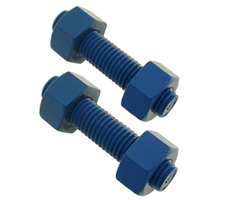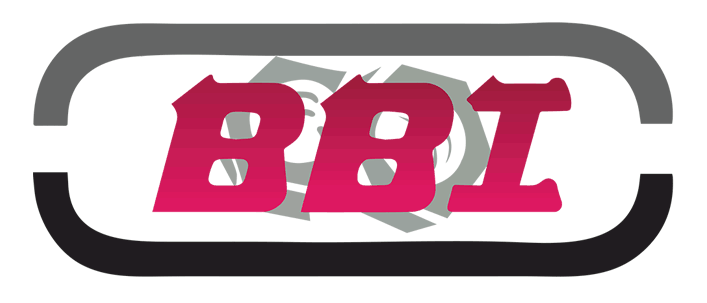Coating : Coated bolts
An exclusive Hot Dip Galvanizing facility that operates 100% under the surveillance of the QC Department at BBI
Baseline Bolts Industries sports a one-of-its-kind “Electrolytic Zinc Plating” facility (in-house) that is fully equipped to make quicker deliveries possible. Moreover, it comes under the hawk-eye surveillance of our in-house quality control department.
The galvanic process is all about employing electrolysis to coat the surface of the product with zinc. The process uses an aqueous solution paired with electrolysis which results in a solid zinc deposit, consequently producing a smooth and bright layer. The layer thickness varies between 5 & 40 µm; well, it is most likely determined by the immersion time and density recorded at that specific time in the zinc bath.
Our in-house Hot Dip Galvanizing facility functions completely under the surveillance of the QC Department. At BBI, all products are hot dipped complying with the internationally applicableISO 1461 standard that can be compared easily to ASTM A-153 standard.
Hot-dip galvanizing fasteners work by the application of centrifuge process that is supported by amplified zinc bath temperature. The process involves immersing the product fully in a molten zinc bath in which a large zinc block is heated well up to 400° C. During the process of immersion, the product is coated by means of a liquid zinc layer. The liquid zinc layer solidifies as soon as we lift the product from the zinc bath.
The in-house Hot Dip Galvanizing facility at BBI is operated completely under the QC Department’s surveillance. All our products are hot dipped according to globally applicable ISO 1461 standard which can be easily compared to the ASTM A-153 standard.
Hot-dip galvanizing fasteners works by means of the centrifuge process supported by increased zinc bath temperature. In the process, the product is fully immersed in a molten zinc bath wherein a large zinc block is well heated to 400° C. In the course of the immersion process, the specific product is coated using a liquid zinc layer. This layer of liquid zinc solidifies the moment the product is lifted from the bath.
Whitford, UK is the major supplier of fluoropolymer topcoat for Baseline Bolts Inc.

Xylan is a fluoropolymer topcoat manufactured by Whitford Corporation. In 1014 and 1070 coatings, Xylan shows high lubricity potential (friction co-efficient is as low as .02) and corrosion resistance of almost 1000 hours (ASTM B117) when applied over phosphate and up to around 2000 hours when applied over electroplating. What’s more, corrosion resistance of the 1400 series is nearly 1500 hours when applied over a suitable basecoat such as zinc electroplating.
Bichromated zinc yellow is a galvanic process. It involves using electrolysis wherein a zinc coating is deposited on the product’s surface. The electrolytic process makes use of an aqueous zinc solution, resulting in a smooth and bright layer. The layer thickness varies between 5 & 40 µm. The current density and immersion time determines the thickness of the layer.
Dacromet offers excellent protection as far as fastening items (small ones) are concerned. Good news is that this centrifugation process happens to be totally environmental friendly. Initially, the products are chemically and mechanically pre-treated. Following that, thin non-electrolytic layers that comprise of zinc and aluminum lamellas are applied on the products in an organic matrix. Layer thickness used is minimal so as to ensure long-lasting protection.
Also referred to as sherardising, this method is largely used to apply a zinc coating in order to provide fastening materials with the required corrosion protection. The products that have to be sherardised are kept in a steel barrel to which sufficient amount of zinc dust is also added. Then, the barrel is placed in an oven that is set to approximately 420° C. During this process, a zinc-iron alloy layer of about 15 – 25 µm thickness is formed, resulting in remarkable corrosion resistance.
ENP is an autocatalytic process. It involves depositing a nickel or phosphorus alloy that is hard & corrosion resistant on a metallic surface. Nickel, the yellowish colored metal, is primarily used to provide a cosmetic finish besides offering corrosion protection. The nickel layer of the raw material is generally sealed off in order to provide superior corrosion resistance. The layer should be generally porous free. Put it simply, the layer should be minimum 20 µm to maximum 40-50 µm in order to guarantee the required corrosion resistance. Sometimes a thinner nickel layer is formed due to the peroxidation of the material. The nickel layer’s finish to be applied could probably be matt, bright or semi-bright. Once the process is done, the product is subject to chrome plating based on the requirement.
Mechanical zinc plating is a tumbling barrel process which involves application of a zinc coating of 3 – 80 µm thickness onto pre-treated steel surface. This is done by tumbling the components with the help of a mixture of tiny glass beads and zinc dust. After the process, the zinc surface becomes lubricated or passivated. In contrast to electrolytic plating, this particular mechanical plating process doesn’t involve hydrogen embrittlement; so, the material doesn’t get weakened.
A bluish-white metal, Chromium is used to provide decorative finishes as well as corrosion protection. When it comes to decorative chromium plating, to begin with, a layer of nickel is always applied. The layer of chromium that is applied over the nickel layer is rather thin and provides a completely different color to the product. The nickel layer must be separated from the environment to facilitate good corrosion resistance; hence, it should be porous-free. Put it simply, the layer should be minimum 20 µm to maximum 40-50 µm in order to guarantee the required corrosion resistance. Sometimes a thinner nickel layer is formed due to the peroxidation of the material. Well, in this process of Chromium plating, what determines the product’s shine is the nickel layer.
